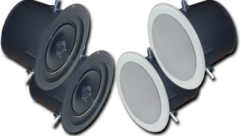The Power Of Pixel Response
Analyzing the impact of LCD pixel response on images in motion.
What is pixel response?How does pixel response impact the image on an LCD/TFT screen?What about pixel response times?
As with most manmade things, no display technology is without its shortcomings. CRTs tend to be large and bulky, plasmas come with burn-in and heat dissipation issues, and LCDs have motion artifacts. In an attempt to address these and other issues, manufacturers continue to develop new technologies. In the midst of this process, as prices for LCD panels come down and sizes go up, many industry observers believe this technology will eventually become the favored display type.
A major difference among display technologies is the way images are displayed. CRTs present images via a scanning beam that energizes red, green, and blue phosphors located near the glass viewing screen. The major benefit of this technology is an ability to display interlaced images from two fields to create a single video frame without difficulty. LCDs on the other hand, function similarly to a film projector and can only display single frames of video. The end result is that LCDs look great with progressive, frame-based images; however, they still have some difficulty with field-based interlaced video — an anomaly most people relate to pixel response.
LCD/TFT screens have groups of red, green, and blue sub-pixels or dots for every pixel. Sub-pixels are basically very tiny light valves that open and close based upon a digital value. When all three sub-pixels are on, the pixel will generate a white image. When all are off, you get black.
Response time (see Fig. 1 at left) has been traditionally defined as the time it takes a pixel to change from black to white (rising time) and then back to black (falling or decay time). This approach is often called “rise-and-fall.” However, many manufacturers are beginning to use a different approach, instead measuring the time between 10 percent and 90 percent of the total amplitude. This method, which tends to minimize errors in the measurement when the source material is saturated to white or driven into negative black, is often called “gray-to-gray” time. As with any electronic device, when comparing any published specifications for an LCD display, it’s important to know which method is being used to derive the numbers.
For most LCD/TFT panels, the rise time is slightly faster than the decay time. In this case, the sum of the two times is used. This value, measured in milliseconds, is used in product specifications.
Panels are specified as “normally white” or “normally black.” This describes the normal display state of the resting, or “off,” pixels. Black screens will usually have a longer decay in the white-to-black transition while white will have longer decay times for black-to-white. The end result is a transition effect, similar to a video dissolve, may occur with each frame update.
In order to answer this question, you must also take into account the frame rates and screen refresh rates used in video applications. Frame rate is determined by the material to be displayed. For video applications, frame rates range from 24 to 60 frames per second (fps). We can determine the period of the individual frame by the equation 1/fps.
Based on the table at right, the fastest standard video frame rate is 60 fps at 17 milliseconds (ms). Of the formats in use today, the progressive frame rates for 1080-60p, 480-60p, and 720-60p are best displayed on LCD/TFT panels with pixel response rates less than 17 ms. Interlace images of 1080-60i, 480-60i (525 lines) are combined to create a single frame measured as 30 fps, while 1080-50i and 480-50i are measured as 25 fps (625 lines) with a period of 40 ms.
The general rule for larger LCD/TFT screens is to make sure the total pixel response time is less than the frame rate. For example, if you’re using an LCD to look at 1080-60i, on a large (12-inch or greater) LCD/TFT screen, the gray-to-gray measured pixel response should be less than 33 ms (see Fig. 2 on page 50). A 720-60p frame rate requires faster pixel response, while 24p can use relatively slower pixel response rates. Why omit smaller screens? Simply put, the smaller the screen, the harder it is to see anomalies. A 1280×768 screen has the same number of pixels no matter what size the screen is. The difference is actual pixel size. Smaller screens have smaller pixels while larger screens have bigger pixels.
We often equate pixel response with motion artifacts inherent in LCD/TFT panels sometimes called “blur.” While pixel response has an impact on blur, the reality is that other factors and processes are in play, amplifying the occurrence of this artifact.
The Power Of Pixel Response
Analyzing the impact of LCD pixel response on images in motion.
What do we see?
“Blur,” “jaggies,” or “smear” artifacts are caused by the way LCD/TFT displays project images. Unlike a CRT, which scans images onto the screen pixel by pixel and line by line, LCD/TFT panels project an entire frame. All pixels of an LCD are turned on for the full duration of the frame period at the same time. CRT scanning beam technology displays one pixel or line at a time by radiating or charging a phosphorus particle bonded to the glass of a CRT. By the time the beam of the CRT moves to the next pixel or line, the previous pixels and lines have already started to decay — kind of like a domino effect.
Because we’ve been accustomed to CRT displays for the last 50 or so years, we see the differences between CRT and LCD/TFT without much effort.
Because LCD/TFT panels are progressive display devices, interlace images must be fully assembled into a single video frame. The assembly of the fields into a frame occurs through a process called de-interlace. Two fields are loaded into a memory device and assembled into a single image. If an image of a fast-moving second hand is de-interlaced, two images (one for each field) will be displayed on the progressive LCD/TFT panel. The difference in motion between fields can be perceived by our eyes as two separate images as well. This occurrence of two bodies in motion happens for each frame, and can appear as a blur in motion because the temporal/spatial difference between the pixels of each field remains the same.
This same blurring phenomenon will occur in progressive frame-based images in the same way a still photo or frame of film does. The primary method to reduce temporal/spatial blur is to increase the sample rates. In a frame of film or a still image, this is controlled by shutter speed and exposure time. As video frame rates become faster or even super sampled at rates faster than frame rate, many blur-type artifacts may become eliminated.
Another method of improving sample rates is to display each field as a progressive image. This can help somewhat with the motion issues, but requires considerable processing of the image.
Take for example a widescreen 525 interlace image projected on a 1920×1080 LCD. Each field of a 525 image has about 240 lines of image information vertically and up to 720 pixels or dots horizontally. To display a single field as a progressive image, it must be enlarged or scaled to eight times original size vertically and 2.7 times horizontally — much the same as looking at an image through a myopic lens magnifying glass. Information must be created from the original pixels (interpolation) to fill this space. Because this process magnifies any negative parts of the image, such as noise from high camera gain or CCD, image aliasing is amplified and can make the final result look pretty bad.
The only fix for this is extensive image analysis and filtering in the interpolation process. In other words, keep the good stuff and throw away the bad. Many display manufacturers are now employing LSIs and proprietary algorithms to make the enlarged image look very good. But you have to ask yourself, “Is it real or artificial?”
After filtering, there are two common processes used to perform field to frame interpolation, intra-field or inter-field. Intra-field uses a single field of data to create a progressive frame on the LCD. This method is often preferred for fast-moving images or live production as it also has less propagation — usually one field. A downside exists when the image is scaled to fill a 1920×1080 display. No matter how you approach the problem, the image must be manipulated to fit on screen. In the case of widescreen standard definition, 240-276 lines of vertical resolution must become 1080 lines, and 720 horizontal pixels must become 1920. Interpolation of the pixels for intra-field process is line and pixel repetition to fill the space. Lower resolution screens are better for SD images because they involve less manipulation of the image to fit the screen.
Inter-field interpolation uses information from two or more fields to create the progressive frame for the LCD. A simple de-interlace will create edges or “jaggies” for adjacent lines and pixels in motion representing the spatial difference in the capture period of each field. Jaggies can be reduced by an interpolation process called “blending” where the edges in motion become blurred. Other issues with the basic de-interlace methods are a reduction of image samples by half. Since f1+f2=F, a 60i image will become 30p and may display steppy motion when compared to your CRT. If you’re doing live production with talking head talent, you’ll begin to notice a one frame delay of video to audio with this method.
The best interpolation method at this time involves using samples for at least three fields (current, previous, and next), and will tend to eliminate most visual artifacts. However, your video will now be at least three fields or more delayed from audio. The poor guy monitoring a live satellite downlink through a frame synchronizer may go crazy trying to figure out why he just can’t get a good lip-sync on his new LCD monitor.
The Power Of Pixel Response
Analyzing the impact of LCD pixel response on images in motion.
Can blur be eliminated on an LCD?COMMON MYTHS ABOUT LCD MONITORS
The simple answer is no, not totally. Images captured in interlace format will always have some “blur” as a result of the de-interlace and interpolation process. Progressive images like 480p-60/50fps or 720p can have intra-frame blur of fast-moving images until technology produces shorter than frame rate exposure times for the acquisition device. Image retention during frame transition can also become blurred by the way your eyes perceive the motion. And in some rare cases, slow pixel response times may produce the blur.
At the current sample rates for interlaced video, pixel response is often the mistaken diagnosis for blur. Factors such as image processing, de-interlacing, scaling to fit the screen, and even the physical size of the LCD pixel cluster all add together to create motion artifacts that may appear differently on an LCD/TFT panel than on your CRT.
Myth #1: LCD monitors are “instant-on” devices. Temperature stability is a major factor in LCD performance. All LCD monitors should be turned on with images displayed for 30 to 60 minutes before any critical viewing should occur.
Myth #2: LCDs don’t burn in static images. While impossible in theory, some LCDs do experience image retention problems. In some cases, the valve function of sub-pixels can get “lazy” from lack of “exercise” and can be corrected over time by displaying moving images. Image retention can also be attributed to problematic de-interlace and interpolation techniques, where the “burn in” is retained in a portion of the memory ICs used to hold data for processing and display.
Myth #3: LCDs can’t reproduce blacks. In some cases this is true, especially on LCD screens that have 6-bit color depth. With 262,000 possible color and luminance values per pixel, these pixels often have bigger steps at the lowest and brightest values. In the case of low luminance content, this can result in muddy or washed out images. To counter this, many LCD monitors are limited in range and generate hard black for images below a certain intensity (for example, 15 IRE). Eight-bit displays have more than 16 million possible values, but can experience the same lack of quantized resolution with lower luminance values and are often clipped to give the appearance of a “crisper” image. The best way to know what the LCD is really doing is to ask the monitor manufacturer to provide a Gamma curve, which will instantly show the luminance limits programmed into the monitor.
Myth #4: Higher resolution LCD screens generate the best video images. In the case of LCDs, resolution is determined by the image you’re providing. If you’re mainly viewing standard definition images, lower resolution LCD screens will actually generate better images. The key is to match the resolution of the LCD screen to the image format you generate.
Myth #5: LCD manufacturers have conspired to eliminate CRT displays. A major component of CRTs is the lead used in the mask of a CRT. Many countries and states in the U.S. (California, for example) have legislated bans or recycling fees for products with lead, identifying these items as possible environmental hazards. CRT technology isn’t “green,” while the newer LCD screens are much more environment-friendly, consume much less power, and may even be designed for refurbishment as a form of recycling.
Robert Foster is national sales manager at Marshall Electronics, El Segundo, CA. He can be reached at [email protected].










